Ski report from Abisko and Norwegian cabins, April 1998
Also available translated to German.
If you want the background to these stories, see the introduction.
Photographs are included in this text, but if you prefer you
can look at the photos separately in the gallery.
The first part of this report is again a catalogue of disappointing weather
conditions, so feel free to skip ahead to Cunojaure and Hunddalen.
This year's tour was planned as an easy week's loop from Abisko to Katterat
via Unna Allakas and the Norwegian cabins at Cunojaure and Hunddlaen,
with 3 spare days for side-trips along the way.
Then I would meet up with some friends with a tent and camp
with them for 4 days somewhere north of Riksgränsen.
Due to schedules at work it couldn't start until after March, a time
I would otherwise avoid because of the risk for positive temperatues
and consequent dampness, rain and waxing difficulties.
So it was April 1st before I found myself on the sleeper to Abisko, sharing
with 4 enormous vikings with 30kg packs on their way to camp in Sarek
national park. My feelings of experience and confidence that had built up as I
planned this third winter tour dropped to a sensible level as I sat there
with my child's sled hanging from my pack straps where these guys had ice
axes and crampons.
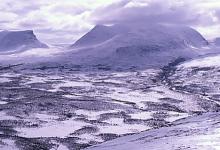 The train was 2 hours late arriving, so I abandoned my plans for an
immediate start and checked into the fjällstation for a bonus luxury
evening with sauna, fresh food and wine. The 4-day weather fax boldly
proclaimed sun, sun, sun, sun, so there was no hurry to get away.
But first I thought I should awaken my skiing skills by taking a quick run down
Abisko's famous off-piste slalom slope, Njullo. The lift had closed, so I went just
half way up on climbing skins and came down slowly and inelegantly through the icy
wooded section. My confidence fell a little further.
The train was 2 hours late arriving, so I abandoned my plans for an
immediate start and checked into the fjällstation for a bonus luxury
evening with sauna, fresh food and wine. The 4-day weather fax boldly
proclaimed sun, sun, sun, sun, so there was no hurry to get away.
But first I thought I should awaken my skiing skills by taking a quick run down
Abisko's famous off-piste slalom slope, Njullo. The lift had closed, so I went just
half way up on climbing skins and came down slowly and inelegantly through the icy
wooded section. My confidence fell a little further.
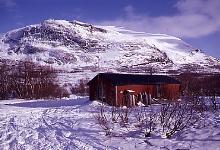 I had paid the minimum rate which gave me a place in a 4-bed room, but no-one else
arrived, and after an undisturbed night I set off happily on the rather dull but
far from unpleasant 15 kilometres south to Abiskojaure in -10 C windless sun.
The winter track is planned to be passable by anyone any winter, but to
achieve this it takes a rather meandering route, and so I followed the example
of many others and took the summer route down to the river, which saved time
and was very
easy to ski along.
I had paid the minimum rate which gave me a place in a 4-bed room, but no-one else
arrived, and after an undisturbed night I set off happily on the rather dull but
far from unpleasant 15 kilometres south to Abiskojaure in -10 C windless sun.
The winter track is planned to be passable by anyone any winter, but to
achieve this it takes a rather meandering route, and so I followed the example
of many others and took the summer route down to the river, which saved time
and was very
easy to ski along.
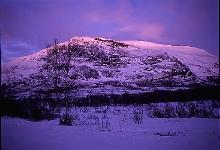 This went well until I got to where the scooter track to
Kårsavagge crosses, when all the ski tracks veered off leaving me to make my
own tracks over the ice, which was developing disturbingly large holes as the
gradient minutely increased. I thought it best to veer off too and find the winter
track, which should have finished its meandering soon. 1km doesn't sound very
far, but when birch trees start popping up closer together than the width of
the sled you are hauling, such a short detour can take a long time, I
discovered. Still, I got to the cabins in 4 1/2 hours, and residual thoughts
of work slid away as I sawed logs and fetched water from a hole in the ice,
under the massive chiselled face of Kieron that towers more than 1000m
over the lake.
This went well until I got to where the scooter track to
Kårsavagge crosses, when all the ski tracks veered off leaving me to make my
own tracks over the ice, which was developing disturbingly large holes as the
gradient minutely increased. I thought it best to veer off too and find the winter
track, which should have finished its meandering soon. 1km doesn't sound very
far, but when birch trees start popping up closer together than the width of
the sled you are hauling, such a short detour can take a long time, I
discovered. Still, I got to the cabins in 4 1/2 hours, and residual thoughts
of work slid away as I sawed logs and fetched water from a hole in the ice,
under the massive chiselled face of Kieron that towers more than 1000m
over the lake.
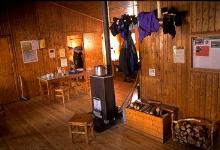 Some older April-type skiers arrived, and then a group of happy young people
on an STF-organised tour, who after a tantalising touch-down in our stuga decided that they
should go and colonise one of the other empty cabins by themselves.
Luckily it was cold there, so a lovely Stockholmer called Karin came back to warm up,
and entertained me with tales of her two weeks kayak camping in Greenland.
Everyone was in bed by 8:30, and despite a late start the silence and darkness
subdued my normal restlessness and I too was in bed by 9:30, looking forward
to another beautiful day for the next leg, which had been such a nightmare the
year before.
Some older April-type skiers arrived, and then a group of happy young people
on an STF-organised tour, who after a tantalising touch-down in our stuga decided that they
should go and colonise one of the other empty cabins by themselves.
Luckily it was cold there, so a lovely Stockholmer called Karin came back to warm up,
and entertained me with tales of her two weeks kayak camping in Greenland.
Everyone was in bed by 8:30, and despite a late start the silence and darkness
subdued my normal restlessness and I too was in bed by 9:30, looking forward
to another beautiful day for the next leg, which had been such a nightmare the
year before.
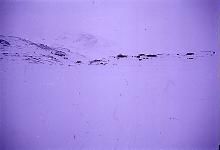 But history repeated, and I awoke to -5C, 5 m/s headwind, low
cloud and horizontal snowfall. At least this year I'd got a good night's sleep,
and it was fun to wave goodbye to the women who had been mocking me
all the night before because I had more gear with me than they did, but who
were now panicking because they felt underequiped to go out in the mildly-bad weather,
and would thus risk missing their train home.
It was a long 20km to Alesjaure, and very frustrating since it was obvious
that it would be beautiful in good weather. After a couple of kilometers there
is a steep climb up 400m over about 4km, and then it's almost flat along
Alesjaure the rest of the way. I had planned lunch at the recently-built
Kungsstugan, but I noticed that it was occupied by the overly intense and
talkative guy who had plagued me over breakfast, and since I had come to the
mountains to escape stress, I chose instead to lunch in my new windsack a
little further on.
Soon after, I topped a small island and was confronted by what looked like the
cabins of Alesjaure, dead ahead and quite close. Since they should have been
6km away I was confused and wondered how I could have missread the map so
badly, so I pulled out the GPS
receiver that I had buried away for whiteouts
and emergencies. 5.8km it agreed, and I reluctantly accepted that the long
flat lake had distorted the apparent distance, and that I had 2 hours
of tedious skiing ahead, taunted by the imperceptably advancing cabins. While
I was in my toy box I pulled out the wind meter and was surprised to find that
the wind was now gusting over 15 m/s. Ho hum. I was fairly comfortable in my
Activent trousers and Gore-Tex jacket, but sometimes I'd felt a little cold
and damp, especially my arms. This feeling went away as I neared
the Alesjaure cabins, and when I arrived I found out that this was because the inside of
my jacket arms had frozen, a common but fairly harmless phenomenon with
breathable shells in cold wind.
But history repeated, and I awoke to -5C, 5 m/s headwind, low
cloud and horizontal snowfall. At least this year I'd got a good night's sleep,
and it was fun to wave goodbye to the women who had been mocking me
all the night before because I had more gear with me than they did, but who
were now panicking because they felt underequiped to go out in the mildly-bad weather,
and would thus risk missing their train home.
It was a long 20km to Alesjaure, and very frustrating since it was obvious
that it would be beautiful in good weather. After a couple of kilometers there
is a steep climb up 400m over about 4km, and then it's almost flat along
Alesjaure the rest of the way. I had planned lunch at the recently-built
Kungsstugan, but I noticed that it was occupied by the overly intense and
talkative guy who had plagued me over breakfast, and since I had come to the
mountains to escape stress, I chose instead to lunch in my new windsack a
little further on.
Soon after, I topped a small island and was confronted by what looked like the
cabins of Alesjaure, dead ahead and quite close. Since they should have been
6km away I was confused and wondered how I could have missread the map so
badly, so I pulled out the GPS
receiver that I had buried away for whiteouts
and emergencies. 5.8km it agreed, and I reluctantly accepted that the long
flat lake had distorted the apparent distance, and that I had 2 hours
of tedious skiing ahead, taunted by the imperceptably advancing cabins. While
I was in my toy box I pulled out the wind meter and was surprised to find that
the wind was now gusting over 15 m/s. Ho hum. I was fairly comfortable in my
Activent trousers and Gore-Tex jacket, but sometimes I'd felt a little cold
and damp, especially my arms. This feeling went away as I neared
the Alesjaure cabins, and when I arrived I found out that this was because the inside of
my jacket arms had frozen, a common but fairly harmless phenomenon with
breathable shells in cold wind.
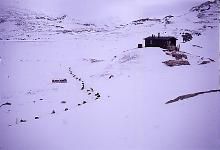
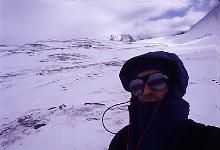 The main cabin was full of very nice Norwegians, plus a German girl with a
huge dog who'd chosen to emmigrate and work as a postman way up in Kirkenes
in order to be nearer the mountains. She was very handy with an axe.
I sawed wood with her and fetched water for the sauna,
and hoped to meet the STF group
there, but my timing was bad and I got stuck with the over-excitable guy again.
I also hoped to roll in the snow, but there was just wind-blown ice outside, and that
just didn't seem as inviting somehow.
The following day brought dull weather again, +2 C and grey, so I decided
to stay put and hope for better visibility for the potentially beautiful next
leg. Instead I took a short trip around Turkitjåka, but it was icy and rocky,
and not much fun.
Earlier we had been visited by a police helicopter, as it turned out that the
king and queen would be passing by later, and as I skied past the Sami village I was
intercepted by two policemen on scooters who wanted to know who I was and what
I was doing. With my poor command of Swedish vowels I could only hope that
they heard "tourist" rather than "terrorist". I later heard that the king
had invited other guests for a salmon lunch while I was out skiing. Bad timing again.
I had fallen and broken my sunglasses at one point during the day,
and delayed mending them for about half an hour until I got to a
sheltered spot. That evening my corneas itched terribly, presumably
snowblindness caused by that brief exposure to grey skies, coupled with hypersensitivity
borne of greater carelessness with eye protection on my first winter tour.
The main cabin was full of very nice Norwegians, plus a German girl with a
huge dog who'd chosen to emmigrate and work as a postman way up in Kirkenes
in order to be nearer the mountains. She was very handy with an axe.
I sawed wood with her and fetched water for the sauna,
and hoped to meet the STF group
there, but my timing was bad and I got stuck with the over-excitable guy again.
I also hoped to roll in the snow, but there was just wind-blown ice outside, and that
just didn't seem as inviting somehow.
The following day brought dull weather again, +2 C and grey, so I decided
to stay put and hope for better visibility for the potentially beautiful next
leg. Instead I took a short trip around Turkitjåka, but it was icy and rocky,
and not much fun.
Earlier we had been visited by a police helicopter, as it turned out that the
king and queen would be passing by later, and as I skied past the Sami village I was
intercepted by two policemen on scooters who wanted to know who I was and what
I was doing. With my poor command of Swedish vowels I could only hope that
they heard "tourist" rather than "terrorist". I later heard that the king
had invited other guests for a salmon lunch while I was out skiing. Bad timing again.
I had fallen and broken my sunglasses at one point during the day,
and delayed mending them for about half an hour until I got to a
sheltered spot. That evening my corneas itched terribly, presumably
snowblindness caused by that brief exposure to grey skies, coupled with hypersensitivity
borne of greater carelessness with eye protection on my first winter tour.
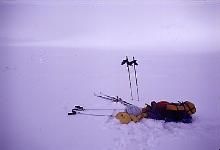 I had another sauna, this time with some colourful Norwegains from Harstad,
and then went to bed where I tried in vain to sleep through the incredible
snoring of my roommate, which penetrated even earplugs. I gave up and moved
into the drying room with all the damp boots, and woke unrefreshed and aching,
to more miserable weather, 0 C, 5 m/s and grey. After stocking up on a week's
supply of hard bread and freeze-dried dinners in the shop I staggered off towards Unna
Allakas, immediately confronted by a 300m rise over 3km that took me
about an hour to climb.
I had another sauna, this time with some colourful Norwegains from Harstad,
and then went to bed where I tried in vain to sleep through the incredible
snoring of my roommate, which penetrated even earplugs. I gave up and moved
into the drying room with all the damp boots, and woke unrefreshed and aching,
to more miserable weather, 0 C, 5 m/s and grey. After stocking up on a week's
supply of hard bread and freeze-dried dinners in the shop I staggered off towards Unna
Allakas, immediately confronted by a 300m rise over 3km that took me
about an hour to climb.
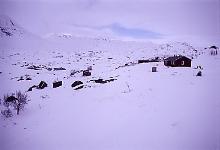 Then it is an undulating plateau for 4km, before a
kilometre-long 15 degree slope down to another long plateau. I unhitched the
sled here and sent it off to explore the slope by itself, and then tried to
telemark after it. But the surface was a breakable crust that rather spoiled
my style and I was met at the bottom by a concerned Norwegian couple who
offered to tow me behind their scooter. This sounded like a skill I should
learn, and since I was so tired, the idea of skipping an hour or more skiing
a long flat stretch with no view was just too tempting.
So I was soon doing 40 km/hr across the plateau, which was
much like waterskiing with a block of dry ice stuffed down your trousers.
They dropped me when the terrain got steep again, but took my sled on the cabin
so that I could ski unfettered.
Then it is an undulating plateau for 4km, before a
kilometre-long 15 degree slope down to another long plateau. I unhitched the
sled here and sent it off to explore the slope by itself, and then tried to
telemark after it. But the surface was a breakable crust that rather spoiled
my style and I was met at the bottom by a concerned Norwegian couple who
offered to tow me behind their scooter. This sounded like a skill I should
learn, and since I was so tired, the idea of skipping an hour or more skiing
a long flat stretch with no view was just too tempting.
So I was soon doing 40 km/hr across the plateau, which was
much like waterskiing with a block of dry ice stuffed down your trousers.
They dropped me when the terrain got steep again, but took my sled on the cabin
so that I could ski unfettered.
Unna Allakas has a great setting,
and the skies even cleared briefly so that I could appreciate it. I used the
time I'd saved to have a long lunch with a German there, and then whizzed
5km across the border to Cunojaure.
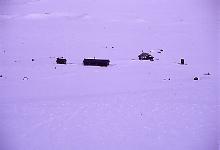
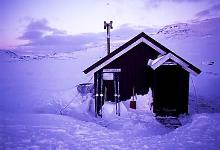 Cunojaure was my first experience of
Norwegian cabins and the first thing I noticed was that they are older and cosier
than most Swedish cabins, and that they were decorated in a homely way
with checked tablecloths and colourful curtains.
Very welcoming. You need a
key to get in, which I had borrowed from friends, but they can also be bought or
borrowed from DNT in Narvik,
or the fjällstation in Abisko.
I believe that cabins all over Norway now use
the same key. Up here the cabins have no wardens, and there tends not to be a
water hole or plentiful wood supply. Heating is by coal, which is harder to
light but burns longer into the night. Paraffin lamps are supplied.
When I arrived there were two guys sleeping in the cabin, which I later learned
was because they too had shared with a snorer the night before. There were no
chores to be done, so I too dozed in an armchair, and then took a brief tour before
dinner.
Cunojaure was my first experience of
Norwegian cabins and the first thing I noticed was that they are older and cosier
than most Swedish cabins, and that they were decorated in a homely way
with checked tablecloths and colourful curtains.
Very welcoming. You need a
key to get in, which I had borrowed from friends, but they can also be bought or
borrowed from DNT in Narvik,
or the fjällstation in Abisko.
I believe that cabins all over Norway now use
the same key. Up here the cabins have no wardens, and there tends not to be a
water hole or plentiful wood supply. Heating is by coal, which is harder to
light but burns longer into the night. Paraffin lamps are supplied.
When I arrived there were two guys sleeping in the cabin, which I later learned
was because they too had shared with a snorer the night before. There were no
chores to be done, so I too dozed in an armchair, and then took a brief tour before
dinner.
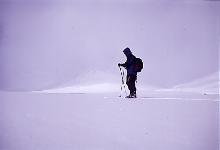
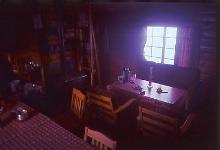 And it was beautiful ! The clouds and wind had vanished, and for the
first time on this trip I saw the full beauty of Lappland - unending, quiet,
remote, unspoiled. This is why I had struggled all those uncomfortable hours.
Perfection. We shared our luxury foods, their chocolate and my dried strawberries,
and went to bed early, anticipating a great day's skiing ahead.
And it was beautiful ! The clouds and wind had vanished, and for the
first time on this trip I saw the full beauty of Lappland - unending, quiet,
remote, unspoiled. This is why I had struggled all those uncomfortable hours.
Perfection. We shared our luxury foods, their chocolate and my dried strawberries,
and went to bed early, anticipating a great day's skiing ahead.
Which one should never do, since it guarantees bad weather. Low clouds, -7C,
10 to 15 m/s in this case. Headwind, naturally. I trudged off again, but at
least this day the sky cleared regularly to show me what a nice place I was in.
I later learned that the Norwegians had headed north that day, and came across a Swedish couple
who were lost and dangerously hypothermic, so they had had to stop and get into sleeping bags
naked with them to warm them up. "And I got the girl !" reported one of them in an email to me
"And don't tell my friend, but it's nowhere near as much fun as it sounds".
Navigation east was easy since I was in a deep valley, and even though I was on 20
degree traverses sometimes, my sled behaved perfectly, thanks to
modifications I'd made for this year.
I stopped regularly, trying to coincide with the sunny periods, but my major
lunch break happened to hit a wind peak,
and I wondered if I would lose my windsack.
Then I stopped at the Kvillebo wind shelter for tea, and when I came
out my skis had already been buried in the snow. After 8 hours of plodding
17km and the rather more exciting icy descent to Hunddalen, I reached the group
of cabins, and moved in with yet another nice Norwegian couple, a rare English
couple, and an irritatingly arrogant old German.
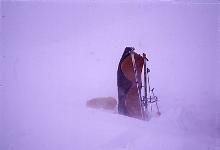
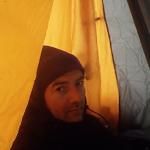 As I went to bed I could hear
the wind whistling through the wires that held the cabins down.
In the morning I felt rested even though it seemed like I had been conscious all night.
That's happened before after extreme exertion, as though my body can't slow
down again. At 7 o'clock I could hear that the wind had stopped.
Great ! At 7:30
it was back with even heavier snow fall. At 8 it was clear and still,
and sight was unlimited. I got up.
10km downhill to Katterat would be a sheer joy in the new snow.
I felt good, and made a hefty breakfast of porridge to replenish
the previous day's excessive consumption. 9 o'clock brought more
snowfall with it.
It was clearly going to be a schizophrenic day.
I set off into the heavy snow with almost no visibility, but was confident
of easily finding the winter track. I'd been in much worse conditions, and
this was an easy stretch, right ?
As I went to bed I could hear
the wind whistling through the wires that held the cabins down.
In the morning I felt rested even though it seemed like I had been conscious all night.
That's happened before after extreme exertion, as though my body can't slow
down again. At 7 o'clock I could hear that the wind had stopped.
Great ! At 7:30
it was back with even heavier snow fall. At 8 it was clear and still,
and sight was unlimited. I got up.
10km downhill to Katterat would be a sheer joy in the new snow.
I felt good, and made a hefty breakfast of porridge to replenish
the previous day's excessive consumption. 9 o'clock brought more
snowfall with it.
It was clearly going to be a schizophrenic day.
I set off into the heavy snow with almost no visibility, but was confident
of easily finding the winter track. I'd been in much worse conditions, and
this was an easy stretch, right ?
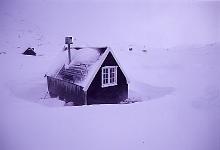
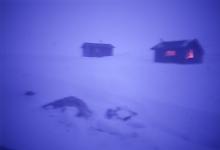 20cm of new snow was hard work with the sled, but after 20 mins I met a
Norwegian couple
heading to Hunddalen and I happily retraced their tracks, with only a brief thought
for how they had managed to get there before the first train came to Katterat.
Half an hour later their tracks stopped. No sign of a camping site, just a
clean turn. Odd. Still, I was pretty much where I expected the winter track
to be, and I carried on. Suddenly the skies cleared and I could see the valley
I was headed for, and everything looked fine except for the 20m plummet
into the narrow ravine in front of me, so narrow that it didn't show on my map.
I hiked painfully up around the source and continued, but I was now clearly
not where the track should be. Still, I was in a valley that headed due north
to Katterat, and after whizzing across the basin I was just 6km away with 4 hours
to the last train.
20cm of new snow was hard work with the sled, but after 20 mins I met a
Norwegian couple
heading to Hunddalen and I happily retraced their tracks, with only a brief thought
for how they had managed to get there before the first train came to Katterat.
Half an hour later their tracks stopped. No sign of a camping site, just a
clean turn. Odd. Still, I was pretty much where I expected the winter track
to be, and I carried on. Suddenly the skies cleared and I could see the valley
I was headed for, and everything looked fine except for the 20m plummet
into the narrow ravine in front of me, so narrow that it didn't show on my map.
I hiked painfully up around the source and continued, but I was now clearly
not where the track should be. Still, I was in a valley that headed due north
to Katterat, and after whizzing across the basin I was just 6km away with 4 hours
to the last train.
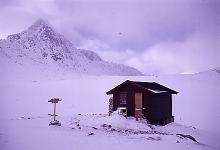
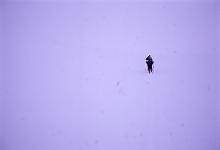 Then things got ugly. The valley narrowed, and big rocks and precipices
loomed out of the renewed snowfall. Following the river clearly wasn't safe
with this visibility. I would have to get back to the track, but the walls
around me were very steep and I would have to backtrack a lot to keep my climb
to around 20 degrees, which was all I could manage with the sled in heavy snow.
I climbed until the walls suddenly became 45 degrees, but saw no sign of the track.
Now I was up on the level of the summer trail, and decided to keep heading north
in the hope that it was passable in winter. Occasionally the skies would clear and
I would see the 400m drop to where I wanted to be, and the black walls of
the parallel ridge that were too steep to hold snow.
I started to consider the feasibility of spending the night in my windsack,
and I ate no lunch in case it cost me a precious clear-sky period that might show me a way out.
I found myself on a 700m summit to which the summer trail led and from which I could
see a plateau maybe 50m below. I had to guess at the heights because although
Swedish maps show contours across the border, they don't label them on the
Norwegian side.
Then things got ugly. The valley narrowed, and big rocks and precipices
loomed out of the renewed snowfall. Following the river clearly wasn't safe
with this visibility. I would have to get back to the track, but the walls
around me were very steep and I would have to backtrack a lot to keep my climb
to around 20 degrees, which was all I could manage with the sled in heavy snow.
I climbed until the walls suddenly became 45 degrees, but saw no sign of the track.
Now I was up on the level of the summer trail, and decided to keep heading north
in the hope that it was passable in winter. Occasionally the skies would clear and
I would see the 400m drop to where I wanted to be, and the black walls of
the parallel ridge that were too steep to hold snow.
I started to consider the feasibility of spending the night in my windsack,
and I ate no lunch in case it cost me a precious clear-sky period that might show me a way out.
I found myself on a 700m summit to which the summer trail led and from which I could
see a plateau maybe 50m below. I had to guess at the heights because although
Swedish maps show contours across the border, they don't label them on the
Norwegian side.
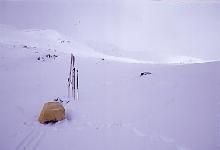
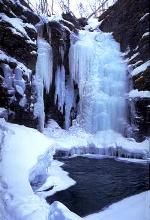 The light was good enough now to see that maybe I could get down, but not
good enough to be sure, and at around 30 degrees it was a one-way street.
I considered the avalanche possibility, having had both strong winds
and heavy snow in the last 48 hours, but many rocks showed through,
which I hoped would stabilize the layers. I came down surprisingly elegantly
and felt very proud that my sled followed faithfully. I came to the north
end of the plateau and tried to see how steep it was for the next 300m drop,
but it was so steep that I dared not get close enough to find out just how steep.
But at the western edge I saw a delightfully shallow ravine heading down to the forest,
where I thought things would get easier, but it was in fact a nightmare of densely-packed
birches that snagged my sled continuously. Less than 1km to go in 45 minutes.
Could I really miss my train ? I didn't, but only with a 5 minutes margin,
so I was very glad I hadn't had lunch as there is no road to the place,
just a very cold station platform, or another 10km of steep untracked skiing
to Katterjåkk, which is where I took the train now. I had phoned the
Tourist Station there the week before and they had said that they always had a floor
somewhere for a desperate skier passing by. But not today, apparently.
In the end the guy kindly drove me to Abisko, where they really do always have floor space.
It was a pity that I would now miss my day's slalom skiing at the ledgendary
Riksgränsen, but I got to play at ice-climbing instead. I even got
a room to myself again, and I lay on the bed replaying the day. I felt that
I had been close to the edge, both literally and figuratively, yet all the
decisions I made had been good ones. I just shuddered a bit to think what would have
happened if I hadn't been so clear-headed this day. I suppose I would have realised,
and backed off. Wouldn't I ?
The light was good enough now to see that maybe I could get down, but not
good enough to be sure, and at around 30 degrees it was a one-way street.
I considered the avalanche possibility, having had both strong winds
and heavy snow in the last 48 hours, but many rocks showed through,
which I hoped would stabilize the layers. I came down surprisingly elegantly
and felt very proud that my sled followed faithfully. I came to the north
end of the plateau and tried to see how steep it was for the next 300m drop,
but it was so steep that I dared not get close enough to find out just how steep.
But at the western edge I saw a delightfully shallow ravine heading down to the forest,
where I thought things would get easier, but it was in fact a nightmare of densely-packed
birches that snagged my sled continuously. Less than 1km to go in 45 minutes.
Could I really miss my train ? I didn't, but only with a 5 minutes margin,
so I was very glad I hadn't had lunch as there is no road to the place,
just a very cold station platform, or another 10km of steep untracked skiing
to Katterjåkk, which is where I took the train now. I had phoned the
Tourist Station there the week before and they had said that they always had a floor
somewhere for a desperate skier passing by. But not today, apparently.
In the end the guy kindly drove me to Abisko, where they really do always have floor space.
It was a pity that I would now miss my day's slalom skiing at the ledgendary
Riksgränsen, but I got to play at ice-climbing instead. I even got
a room to myself again, and I lay on the bed replaying the day. I felt that
I had been close to the edge, both literally and figuratively, yet all the
decisions I made had been good ones. I just shuddered a bit to think what would have
happened if I hadn't been so clear-headed this day. I suppose I would have realised,
and backed off. Wouldn't I ?
© Mark Harris 1998
(On to winter camping)
(Back to ski report index)
(MRH homepage)

 The train was 2 hours late arriving, so I abandoned my plans for an
immediate start and checked into the fjällstation for a bonus luxury
evening with sauna, fresh food and wine. The 4-day weather fax boldly
proclaimed sun, sun, sun, sun, so there was no hurry to get away.
But first I thought I should awaken my skiing skills by taking a quick run down
Abisko's famous off-piste slalom slope, Njullo. The lift had closed, so I went just
half way up on climbing skins and came down slowly and inelegantly through the icy
wooded section. My confidence fell a little further.
The train was 2 hours late arriving, so I abandoned my plans for an
immediate start and checked into the fjällstation for a bonus luxury
evening with sauna, fresh food and wine. The 4-day weather fax boldly
proclaimed sun, sun, sun, sun, so there was no hurry to get away.
But first I thought I should awaken my skiing skills by taking a quick run down
Abisko's famous off-piste slalom slope, Njullo. The lift had closed, so I went just
half way up on climbing skins and came down slowly and inelegantly through the icy
wooded section. My confidence fell a little further.



















